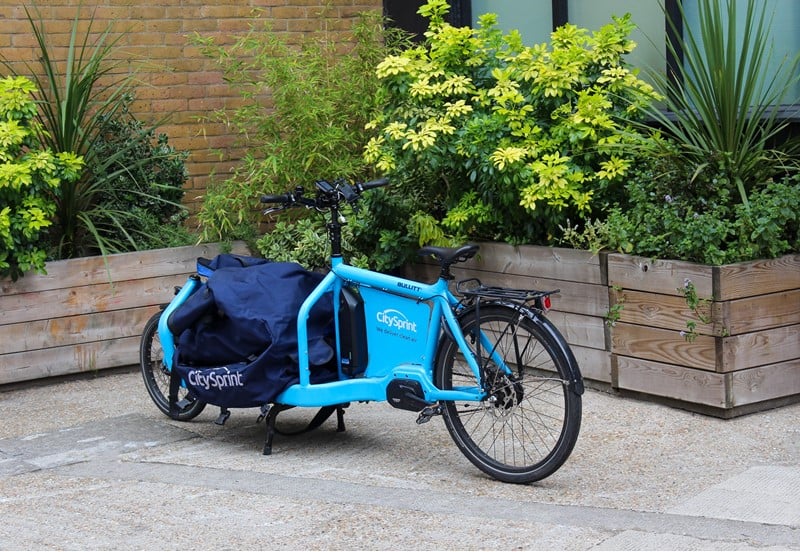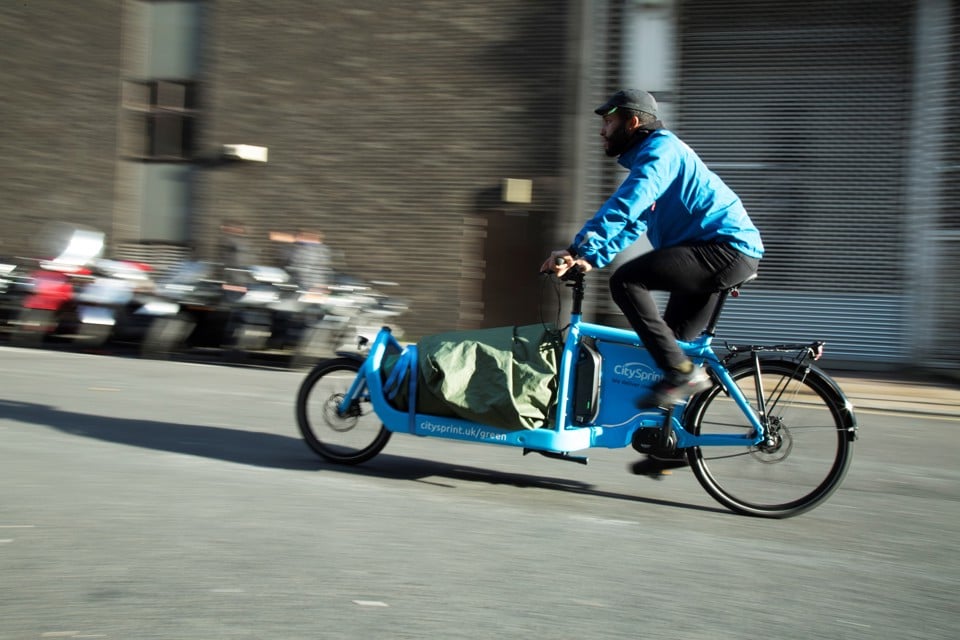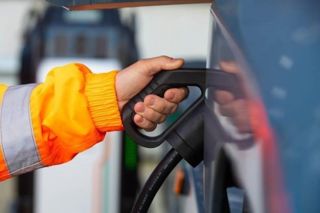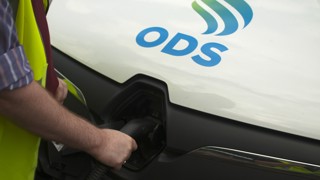This feature originally appeared in the July 2020 edition of Fleet News. Read the digital issue of the magazine by clicking here
There’s nothing new about transporting or delivering goods by bicycle; businesses were doing that 100 years ago.
But for many organisations, pedal power could play an important role in their fleets of the future.
Part of this is due to increasing urbanisation and congestion, the growth of home deliveries and the load-carrying abilities of electrically-assisted e-cargo bikes.
Bikes also fit in with two of the Government’s current major transportation focuses: decarbonisation and a push to increase active transport.
The latter has benefits for staff welfare. Energy Saving Trust says some companies report their e-cargo bike riders take less sick leave than other drivers, while London butchers Drings of Greenwich found the four employees trained to use its e-cargo bike burned an additional 2,500 kcals collectively over a fortnight. However, these benefits are unlikely to be the major reason for their uptake.
Instead, their appeal will lay in their zero emission and traffic-busting capability in urban areas as well as to offer significant cost savings compared with operating a van (see panel on page 21).
On the surface, they fulfil many of the requirements a modern fleet demands of its vehicles, so why aren’t they in more widespread use?
“We believe one of the biggest barriers to the wider uptake of cargo bikes is a level of scepticism of their capabilities among businesses,” says Matt Winfield, England director at cycling charity Sustrans.
A fully-loaded e-cargo bike cannot carry as much as a fully-loaded van.
Dutch logistics company PostNL says a fully-loaded truck carries the same cargo as three panel vans, which carry the same amount as 12 two-wheeled cargo bikes.
In this example, if all vans were replaced by e-cargo bikes, instead of hiring one driver an organisation would need to employ four riders, thereby increasing staff costs.
Nor do e-cargo bikes offer the speed or ability to cover long distances a van has.
But, to disregard them for these reasons means a fleet could be missing out on the potential benefits they might bring.
Instead, they should be viewed as “part of the clean transport mix that is required to keep (a) city moving, building resilience as we deal with the challenges of economic recovery, congestion, air pollution and the climate emergency”, says Tom Linton-Smith, project manager at consultancy Cross River Partnership (CRP), which has recently published its Enabling Last Mile Cycling Logistics report.
The main users of e-cargo bikes are parcel and post logistics companies, but an increasingly diverse range of businesses are exploring their possible use.
Supermarkets, including Co-op and Sainsbury’s, have trialled them for home deliveries, while construction business FM Conway is using three e-cargo bikes to carry materials of various sizes and weights, including bags of sand and boxes of fixings, for its work on London’s Illuminated River art project.
What is an e-cargo bike?
An e-cargo bikes is either a two-, three- or four-wheeled bicycle which uses an electric motor to assist the rider when pedalling.
Under the Electrically-Assisted Pedal Cycle (EAPC) regulations, its motor must have a maximum power output of 250w which stops providing assistance if the rider stops pedalling, applies the brakes or reaches 15.5mph. The rider can continue pedalling beyond this.
If it does not meet these requirements, it is classed as a motorcycle, moped or powered light vehicle (PLV) and needs to be registered and taxed.
However, if it qualifies as an e-cargo bike, riders do not need a driving licence or to legally use safety equipment, although helmets, appropriate clothing and training are highly recommended.
E-cargo bikes can travel up to around 50 miles per charge, with a full charge taking between three-and-a-half and five hours from a standard three-pin plug socket.
Dependent on the design, a two-wheeled bike can typically carry a maximum payload of 100kg, increasing to 250kg for three- and four-wheeled versions. A trailer can transport up to 300kg.
“The carrying capacity of our extra-large e-cargo bike is equivalent to a small van, which makes them very flexible,” says Doug Hutchinson, head of sameday at London-based courier Absolutely.
He says the bikes help solve a number of issues for the company. “Recruiting van drivers was becoming a real challenge and once they were out on the road they were getting delayed in traffic, receiving parking tickets and facing further delays trying to avoid road closures,” he adds.
“We still need to maintain our four-wheeled fleet, so we’re continuously investing in vans of all sizes.
“However, we are augmenting this fleet with a very strong backbone of e-cargo bikes. A small van can approximately make 12 deliveries in a single day; an e-cargo bike can do 30.”
This increased efficiency is due to a number of factors, he says, such as an e-cargo bike’s ability to cut through traffic easily, while parking has become “basically a non-existent issue”.
“We know time isn’t being wasted from collection point to delivery location,” adds Hutchinson.
This is also a key finding in other trials, such as those by Drings and Sainsbury’s. Drings used its e-cargo bike for 95% of deliveries below three miles while Sainsbury’s delivered up to 100 orders a day with five bikes from its Streatham Common store. Both reported faster journeys with less congestion and shorter doorstep times by being able to park closer to the delivery location.These experiences support findings of the Cycling Logistics Study, produced for CRP, which says e-cargo bikes can offer a 25% to 50% cut in journey times in London compared with a van.
This is largely due to them being able to access cycle lanes, allowing them to bypass traffic and take more direct routes, offering more reliable delivery timings and, therefore, improving customer satisfaction.
Improving air quality
E-cargo bikes can often be unloaded safely on the pavement, compared with a van which requires a parking space or, in practice, is often parked in such a way which restricts access for other road users and pedestrians while unloading.
These also help reduce congestion, which helps improve air quality. CRP says replacing a diesel van with e-cargo bikes in Central London saves six tonnes of CO2 and at least 14.1kg NOx and 21g of particulate matter each year, based on daily mileage of 50 miles.
Courier CitySprint (see case study below) says each of its 31 e-cargo bikes which has replaced a van saves four tonnes of greenhouse gas emissions each year.
One of its services is for Guys and St Thomas’s Hospitals in London, where it now uses e-cargo bikes instead of motorbikes to transport samples between clinics and laboratories.
With nine trips taking place each day, the switch has removed 3,200 motor vehicle trips, covering 13,600 miles a year.
It is clear that in the right circumstances (see panel, also alongside), e-cargo bikes can offer a variety of benefits to organisations.
Their fortunes also depend on future consumer trends, influenced by factors such as increasing pedestrianisation of city centres, as well as the Covid-19 pandemic.
“The pandemic may change what we buy and where those goods come from,” says Linton-Smith. “There could be a trend to more local sourcing or an acceleration towards more home delivery by vans, especially from supermarkets or restaurants.
“While we cannot be sure what will change and how, we know that two priorities will remain: decarbonisation of our supply chains still needs to occur, and air quality must improve rapidly from pre-lockdown levels.”
Switching can save £6,000 a year
Switching a small diesel van for an e-cargo bike could save an organisation almost £6,000 a year on operating costs on a like-for-like basis, according to calculations from Energy Saving Trust (EST).
As the table below shows, the biggest beneficiaries would be London fleets which could eliminate the congestion charge by switching from a diesel van to either an electric model or an e-cargo bike.
Parking fines – in this example, EST has used a calculation based on FTA and FORS figures – are also a huge saving, while fuel bills could also be cut significantly.
The purchase price of an e-cargo bike is also substantially less at around £4,100, while an e-cargo trike is £7,500.
While the comparisons are on a vehicle-for-vehicle basis, there are still substantial savings should several e-cargo bikes be required to replace one van. However, the cost of additional ‘drivers’ is not taken into consideration.
However, while organisations are able to lease vans, no similar funding method exists for e-cargo bikes at the moment.
Absolutely says cost savings is one of the big advantages of operating e-cargo bikes.
“All of our fleet vehicles incur an initial outlay, which is, essentially, another expense,” says Doug Hutchinson, head of sameday at Absolutely.
“A van, for instance, has to factor any costs of the congestion charge, fuel and other consumables, servicing, potential parking tickets and general running expenses.
“With e-cargo bikes, the initial outlay is smaller and the ongoing servicing and maintenance costs are more modest.
“They do not pay the congestion charge or the ULEZ daily charge. Charging the batteries is virtually an insignificant expense – it costs very little to charge a bike – and there aren’t any parking fines to deal with.”
Case study: CitySprint

Introducing e-cargo bikes has had a “remarkable” impact on CitySprint’s operation in London.
The courier now has 31 e-cargo bikes in the capital after introducing its first five new-age cargo bikes in 2017. It aims to grow its fleet further over the next 12 months including trialling them elsewhere.
“The impact that cargo bikes have on
A to B same-day logistics in London is remarkable – average time from booking to delivery using our cargo bikes is just 54 minutes,” says Mark Footman, operations director at CitySprint.
“The fast turnaround means our bikes fulfil more than 4,000 jobs monthly. And from a sustainability perspective, each cargo bike that replaces a van saves more than four tonnes of CO2 per annum.
“This is a win, win, win situation: the customer receives items faster and their satisfaction increases, couriers complete deliveries faster and can complete more jobs, and the obvious winner is the environment, as cargo bikes have zero emissions and cause less congestion.
“The benefits of cargo bikes cannot be ignored by fleet operators in urban environments.”
Footman says CitySprint has found cargo bikes are a fantastic sustainable alternative to small vans in cities as they can carry a similar load, but can complete journeys up to 50% faster at peak times on weekdays.
They are approximately twice the length of a normal pushbike and the rider sits a few feet behind the front wheel, meaning they are not as straightforward to ride as
a conventional pushbike, he adds.
New riders, therefore, go out with CitySprint’s cargo bike manager for a test ride to ensure they are able to handle the machine.
They are also put on a nursery circuit for their first few weeks to help them adjust to the fast-paced delivery work carried out in the capital.
The bikes undergo regular condition checks and maintenance due to the miles they are doing to ensure they are safe for the road and rider.
“It’s also important to keep the brakes, chains and sprockets in the best condition,” says Footman. “For instance, we change bike brake pads every four to six weeks to ensure ultimate safety and also protect the bike, as if this isn’t done regularly it can cause long-term damage.”
Right vehicle for the right job
For an e-cargo bike to be a success, organisations need to ensure they are used in the right circumstances.
As a general rule, Energy Saving Trust says the following criteria should be met for e-cargo bike deployment:
- Small and light goods as vehicles have a relatively limited space capacity and payload.
- High density network with many stops in a short distance as this is most profitable and vehicles have a limited range, but can be parked easily.
- Time-critical deliveries as small vehicles are less affected by congestion, making them more reliable.
- Congested or access restricted areas as e-cargo bikes are cheaper to use in clean air zones and easier to move around in pedestrianised zones.
The Department for Transport’s latest position on e-cargo bikes is they are best suited to urban areas as they offer few advantages over electric light vans for rural areas due to the distances and, hence, time involved and reduced density of deliveries.






















Login to comment
Comments
No comments have been made yet.